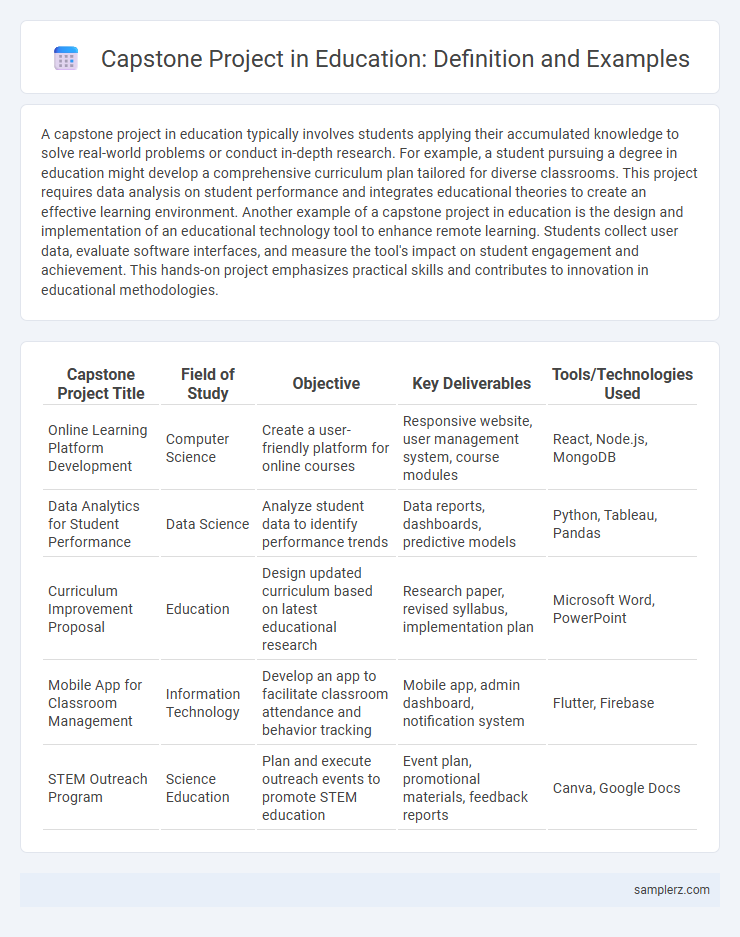A capstone project in education typically involves students applying their accumulated knowledge to solve real-world problems or conduct in-depth research. For example, a student pursuing a degree in education might develop a comprehensive curriculum plan tailored for diverse classrooms. This project requires data analysis on student performance and integrates educational theories to create an effective learning environment. Another example of a capstone project in education is the design and implementation of an educational technology tool to enhance remote learning. Students collect user data, evaluate software interfaces, and measure the tool's impact on student engagement and achievement. This hands-on project emphasizes practical skills and contributes to innovation in educational methodologies.
Table of Comparison
| Capstone Project Title | Field of Study | Objective | Key Deliverables | Tools/Technologies Used |
|---|---|---|---|---|
| Online Learning Platform Development | Computer Science | Create a user-friendly platform for online courses | Responsive website, user management system, course modules | React, Node.js, MongoDB |
| Data Analytics for Student Performance | Data Science | Analyze student data to identify performance trends | Data reports, dashboards, predictive models | Python, Tableau, Pandas |
| Curriculum Improvement Proposal | Education | Design updated curriculum based on latest educational research | Research paper, revised syllabus, implementation plan | Microsoft Word, PowerPoint |
| Mobile App for Classroom Management | Information Technology | Develop an app to facilitate classroom attendance and behavior tracking | Mobile app, admin dashboard, notification system | Flutter, Firebase |
| STEM Outreach Program | Science Education | Plan and execute outreach events to promote STEM education | Event plan, promotional materials, feedback reports | Canva, Google Docs |
Understanding Capstone Projects in Education
Capstone projects in education often require students to synthesize knowledge from multiple disciplines to solve real-world problems, such as designing community literacy programs or developing educational technology tools. These projects emphasize critical thinking, research skills, and practical application, culminating in a comprehensive presentation or portfolio. Effective capstone experiences demonstrate students' mastery of curriculum standards while preparing them for future academic or professional challenges.
Key Features of a Successful Capstone Project
A successful capstone project in education integrates real-world problems with interdisciplinary research, demonstrating critical thinking and practical application. Key features include a clear research question, comprehensive literature review, and a well-structured methodology that guides data collection and analysis. The final deliverable often involves a detailed report and presentation showcasing problem-solving skills and actionable outcomes.
Innovative Capstone Project Examples for Students
Innovative capstone project examples for students include developing AI-powered educational apps that personalize learning experiences and creating sustainable urban farming systems using IoT technology. Students also engage in designing virtual reality simulations to enhance medical training and building blockchain-based platforms to secure academic credentials. These projects demonstrate the integration of cutting-edge technology with real-world problem-solving in education.
Technology-Driven Capstone Projects
Technology-driven capstone projects involve developing innovative solutions such as mobile apps, AI algorithms, or IoT devices to address real-world problems. These projects integrate advanced tools like machine learning, cloud computing, and data analytics, enabling students to demonstrate practical skills and technical expertise. Successful capstone projects might include designing a smart home system, creating a predictive healthcare model, or building an e-commerce platform with user-friendly interfaces.
Science Capstone Project Ideas and Samples
Science capstone projects often involve hands-on experiments or innovative research that apply scientific principles to solve real-world problems, such as developing sustainable energy models or conducting ecological impact studies. Examples include designing a water filtration system using local materials or analyzing the effects of urban pollution on plant growth. These projects encourage critical thinking, data analysis, and interdisciplinary collaboration, essential for achieving academic and practical excellence in science education.
Community-Based Capstone Project Examples
Community-Based Capstone Projects often involve partnerships with local organizations to address real-world issues such as urban sustainability, public health, or education equity. Examples include developing a community garden to promote food security, creating educational workshops for underserved populations, or designing public health campaigns to raise awareness about chronic diseases. These projects emphasize practical solutions and student engagement with community stakeholders to foster social impact and experiential learning.
Interdisciplinary Approaches in Capstone Projects
Capstone projects that integrate interdisciplinary approaches often combine disciplines such as engineering, business, and environmental science to solve complex real-world problems. For example, students might design a sustainable urban development plan that incorporates engineering design principles, economic feasibility studies, and environmental impact assessments. This method enhances critical thinking and collaboration by merging diverse perspectives and expertise into a unified solution.
Real-World Problem Solving through Capstone Work
Capstone projects in education often involve addressing real-world problems such as developing sustainable water management systems or creating affordable housing solutions. Students apply interdisciplinary knowledge and skills to design, implement, and evaluate practical solutions, bridging academic learning with community impact. These projects enhance critical thinking, collaboration, and innovation while preparing students for professional challenges beyond the classroom.
Creative Arts and Humanities Capstone Examples
Creative Arts and Humanities capstone projects often involve producing original works such as documentary films, theatrical performances, or digital art portfolios that demonstrate mastery in visual storytelling and critical analysis. Students may also create comprehensive research papers that analyze historical art movements or cultural phenomena, showcasing their ability to synthesize diverse sources and theoretical perspectives. These projects emphasize interdisciplinary approaches, combining artistic practice with scholarly inquiry to foster innovative expressions and deepen understanding of human culture.
Measuring Success in Capstone Projects
Measuring success in capstone projects involves evaluating clear criteria such as project originality, practical application, and alignment with learning objectives. Metrics like peer reviews, advisor assessments, and real-world impact provide comprehensive insights into student performance and project effectiveness. Tracking these indicators ensures that capstone projects demonstrate critical thinking skills and professional readiness.

example of capstone in project Infographic
 samplerz.com
samplerz.com